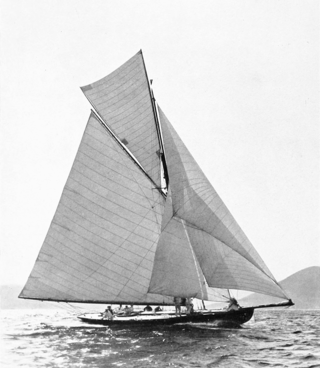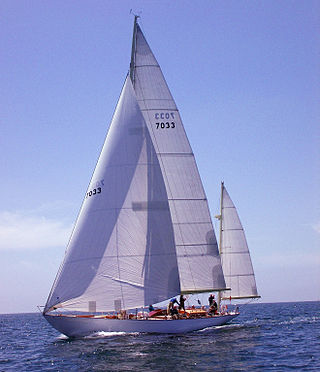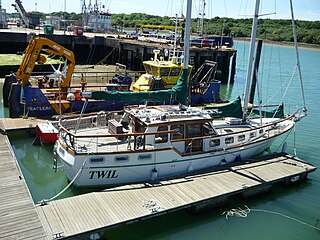
A sloop is a sailboat with a single mast typically having only one headsail in front of the mast and one mainsail aft of (behind) the mast. Such an arrangement is called a fore-and-aft rig, and can be rigged as a Bermuda rig with triangular sails fore and aft, or as a gaff-rig with triangular foresail(s) and a gaff rigged mainsail.

A sailboat or sailing boat is a boat propelled partly or entirely by sails and is smaller than a sailing ship. Distinctions in what constitutes a sailing boat and ship vary by region and maritime culture.

A sailing vessel's rig is its arrangement of masts, sails and rigging. Examples include a schooner rig, cutter rig, junk rig, etc. A rig may be broadly categorized as "fore-and-aft", "square", or a combination of both. Within the fore-and-aft category there is a variety of triangular and quadrilateral sail shapes. Spars or battens may be used to help shape a given kind of sail. Each rig may be described with a sail plan—formally, a drawing of a vessel, viewed from the side.

A yawl is a type of boat. The term has several meanings. It can apply to the rig, to the hull type or to the use which the vessel is put.

A staysail ("stays'l") is a fore-and-aft rigged sail whose luff can be affixed to a stay running forward from a mast to the deck, the bowsprit, or to another mast.

A cutter is a name for various types of watercraft. It can apply to the rig of a sailing vessel, to a governmental enforcement agency vessel, to a type of ship's boat which can be used under sail or oars, or, historically, to a type of fast-sailing vessel introduced in the 18th century, some of which were used as small warships.

Gaff rig is a sailing rig in which the sail is four-cornered, fore-and-aft rigged, controlled at its peak and, usually, its entire head by a spar (pole) called the gaff. Because of the size and shape of the sail, a gaff rig will have running backstays rather than permanent backstays.

In sailing, heaving to is a way of slowing a sailing vessel's forward progress, as well as fixing the helm and sail positions so that the vessel does not have to be steered. It is commonly used for a "break"; this may be to wait for the tide before proceeding, or to wait out a strong or contrary wind. For a solo or shorthanded sailor it can provide time to go below deck, to attend to issues elsewhere on the boat or to take a meal break. Heaving to can make reefing a lot easier, especially in traditional vessels with several sails. It is also used as a storm tactic.
A mast-aft rig is a sailboat sail-plan that uses a single mast set in the aft half of the hull. The mast supports fore-sails that may consist of a single jib, multiple staysails, or a crab claw sail. The mainsail is either small or completely absent. Mast-aft rigs are uncommon, but are found on a few custom, and production sailboats.
The Jolly Boat is a 15 foot ketch rigged open day-boat designed by J. Laurent Giles. Originally designed for plywood construction, more recent examples were made with GRP with plywood decks and bulkheads, manufactured by AJS Marine Services in Chichester. The standard specification was described as a yawl rig, however the mizzen mast is mounted forward of the rudder making the rig a ketch although this is unusual for so small a boat. The foresail is mounted on a bowsprit. A sloop rig version was also available. In the ketch configuration the mainsail is gaff rigged and the mizzen a balanced lug. A steel centre plate and ballast makes the boat quite stable, and the high topsides, broad beam and large cockpit are designed with comfortable family cruising in mind. An outboard well on the port side is provided for a 4h.p. outboard motor.

A sailing yacht, is a leisure craft that uses sails as its primary means of propulsion. A yacht may be a sail or power vessel used for pleasure, cruising, or racing. There is no standard definition, so the term applies here to sailing vessels that have a cabin with amenities that accommodate overnight use. To be termed a "yacht", as opposed to a "boat", such a vessel is likely to be at least 33 feet (10 m) in length and have been judged to have good aesthetic qualities. Sailboats that do not accommodate overnight use or are smaller than 30 feet (9.1 m) are not universally called yachts. Sailing yachts in excess of 130 feet (40 m) are generally considered to be superyachts.
The following outline is provided as an overview of and topical guide to sailing:
The Cal 35 Cruise is an American sailboat that was designed by C. William Lapworth as a cruiser and first built in 1973.
The Crealock 37, also called the Pacific Seacraft 37, is an American sailboat that was designed by British naval architect W. I. B. Crealock as a cruiser and first built in 1978.
The Endeavour 37 is an American sailboat that was designed by Dennis Robbins as racer-cruiser and first built in 1977.

The Tayana 37 is a Taiwanese sailboat that was designed by American Robert Perry as a cruiser and first built in 1976.

The Nauticat 44 is a Finnish motorsailer sailboat that was designed by Kaj Gustafsson as a cruiser and first built in 1974.
The Seafarer 36C is an American sailboat that was designed by Philip Rhodes as a cruiser and first built in 1968. The boat was built with a ketch rig or an optional sloop rig, without the mizzen mast, but with a taller main mast. The design was based on Rhodes Design #702.

A sail plan is a drawing of a sailing craft, viewed from the side, depicting its sails, the spars that carry them and some of the rigging that supports the rig. By extension, "sail plan" describes the arrangement of sails on a craft. A sailing craft may be waterborne, an iceboat, or a sail-powered land vehicle.

















